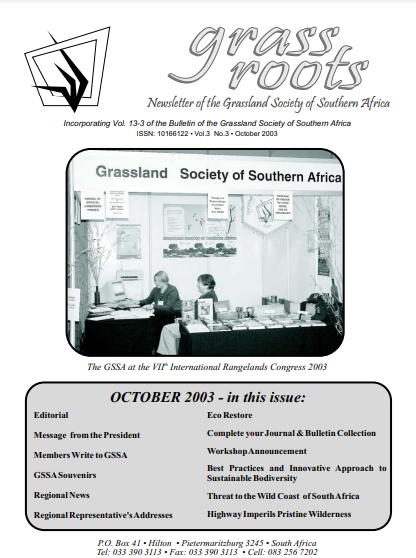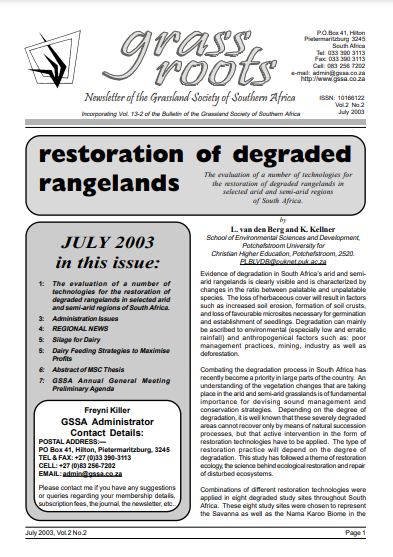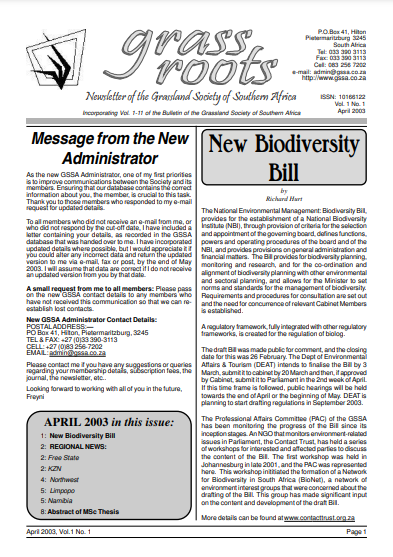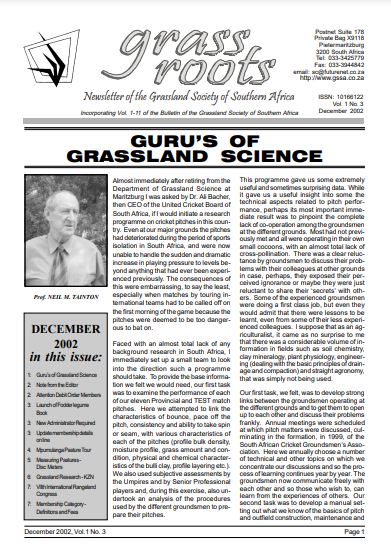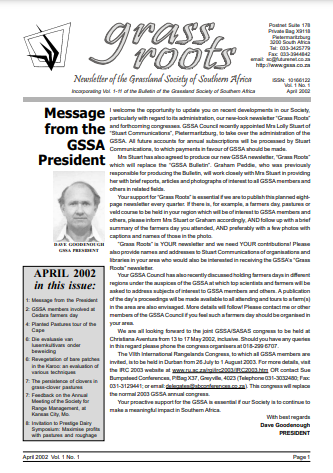Grassroots Issues
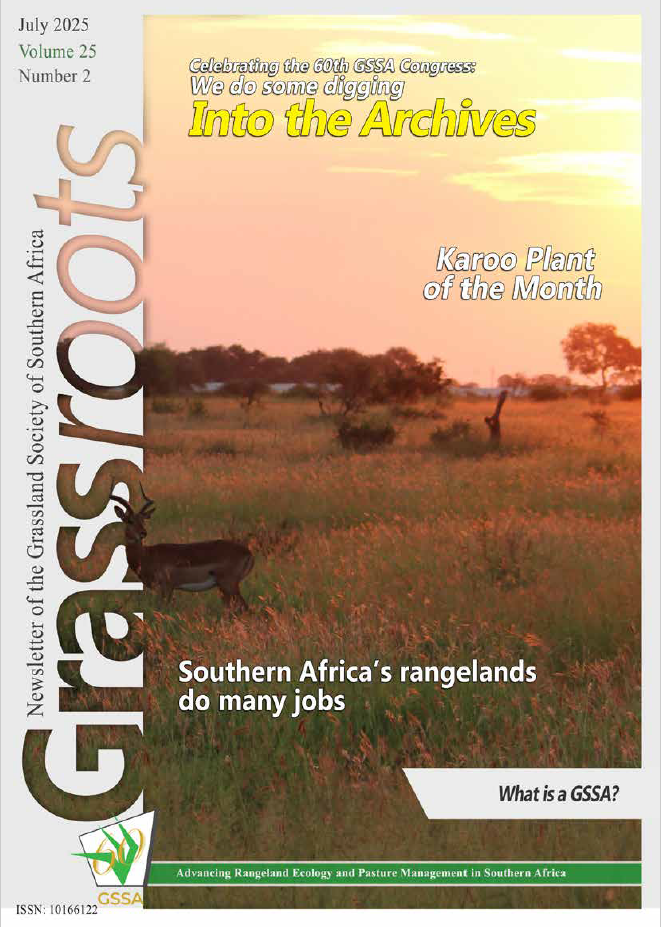
July 2025
As the society celebrates their 60th Congress we have put together a special edition, looking back on the Grassroots newsletters. For this issue we’ve done some serious digging into the archives of just under 100 Grassroots newsletters from the last 23 years. We’ve found many interesting articles, photos, and we are excited to share some insights from this time capsule with you all. We look at the history and future of Grassroots newsletters, it’s purpose and the next steps forward. Regarding recent news, we have an article about African Journal of Range and Forage Sciences’ special issue& a reflective report back on the International Rangelands Congress held last month in Adelaide, Australia. As well as a look at what we can learn from grassland forbs. We hope you enjoy this issue!

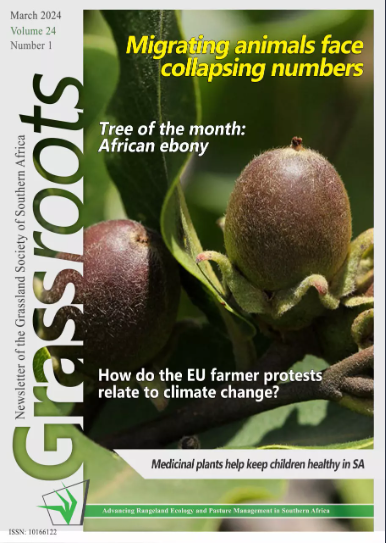
March 2024
This issue is full of recent news, from an analysis on the recent EU farmer protests, the UN's report on declining numbers of migrating animals, and DAFF's outcomes from COP28. Angus Begg's feature article looks at the state of Rietvlei Nature Reserve and it's surrounding community where Corobrik has applied to open a cola mine. Complimenting this is the article from Masego Mafata on mining affected communities.

November 2023
Recent headlines were made when Karpowership, a floating power vessel, reached a offered to donate a game farm to Ezemvelo KZN Wildlife as a biodiversity offset. This follows right after Government published a National Biodiversity Offset Guideline in June. Following this we have articles on car- bon offsets as licence to pollute, and ‘helicopter scientists’. Then we have some news on invasive species, penguins, grassland funding, and a report back from Guy Musto on the International Grassland Congress. Lastly, we have a wonderful obituary commemorating the life of legendary grassland scientist and emeritus Professor, Neil Tainton.

July 2023
For this issue we have no less than three contributions from our members. The two feature articles both look at interesting after- effects of fire on mesic grasslands. Some highlights include N-fixers in grasslands, pyric-herbivory dynamics, the launch of SA's biodiversity banks, and how changing landscapes are affecting butterflies.
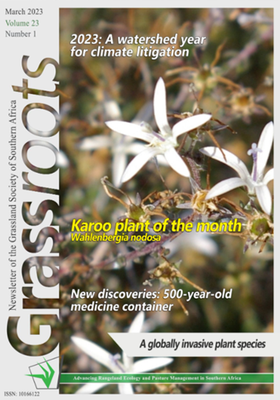
March 2023
We welcome Lisa Matthews as the new editor of the Grassroots. The issue focuses on the interaction between people and nature; ancient dependency, combined with the current impact. Congress 58 will be held at Omaramba, Rustenburg, North West Province, 24 – 28 July 2023.
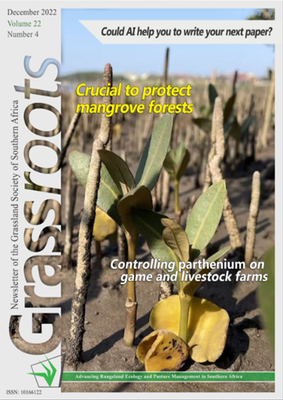
December 2022
Parthenium on game and livestock farms is said to “bring famine and desolation to the land”. In our feature article, Jeremy Goodall and his team explain how certain management practices can be used to maintain the plant at low densities that are not problematic. An invasion of Opuntia aurantiaca (jointed cactus) in South Africa is also reducing valuable grazing land. Learn more about this invasion and how to control it in our feature article by Sive Tokozwayo. The COP27 summit made news headlines for the past month. Read all about the debate by world leaders on the role of livestock in climate change. Heidi-Jayne Hawkins, a research director and fellow at Conservation International feels that the science to mitigate climate change is clear, but the progress is slow. She spoke to University World News about her cross-cutting research that focuses on natural climate solutions, which support climate resilience and mitigation. Barry Meijer is a regenerative farmer in the Klein Karoo and has been incorporating a free satellite-based tool (FruitLook) to efficiently manage the irrigation of his planted pasture.
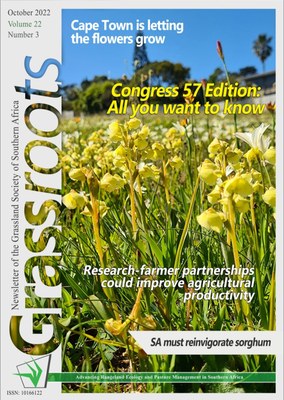
October 2022
The first in-person congress since the outbreak of the COVID-19 pandemic was held at the Aldam Holiday Resort near Ventersburg in the Free State on 25 to 29 July 2022. Read all about it on page 3. The new president of the Society is Charné Viljoen and she will be taking over from Igshaan Samuels. Read all about Dr Urs Kreuter on page 45 who has accepted the position of Scientific Editor of the African Journal of Rangeland and Forage Science as Prof Pieter Swanepoel has stepped down. We are continuing the conversation on the Prosopis invasion with a feature article written by Dr Graham Harding and his team who has been doing a lifetime worth of research on the effect and management of this invasive species. A new “Guide for the Control of Problem Plants South Africa 2022” has also been released. Aife Kearns has an interesting perspective on “Putting a price on nature” in an article where he explains this concept by comparing it to blood donations. On the topic of putting a price on nature, the Opperheimer Research and Conservation awarded a South African ecologist with $150 000 to research new “Cattle with nature” solutions. Lastly, our sincere sympathies go out to Sue Milton and her family with the passing of her husband, Richard Dean.
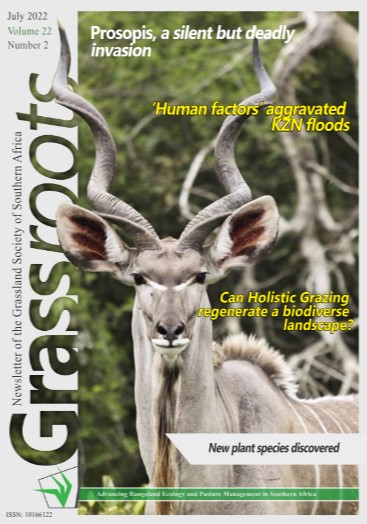
July 2022
This issue highlights the role of grazing in restoring biodiversity with Craig Morris’ feature article on what he learned from investigating “Regenerative Grazing Management” and Susan Marais’ stories of farmers who have seen good results from implementing ultra-high-density grazing. In a case study, Craig Galloway answers the question of what the ideal stocking rate on a pasture-based farm should be. In another feature article, Ken Coetzee explains why we need to be concerned about Prosopis having already spread over 1.8 million hectares of South Africa. And if you have ever wondered how much water we can save by removing alien plants, please read the hydrological study done by a team of researchers from the ARC, Stellenbosch University and the University of Cape Town. New technologies are helping us to collect highly detailed data on the Earth’s land cover (page 39) and smart maps to protect water supplies (page 42). How you respond to reviewers’ comments is an important part of the peer-review process. Saheed Jimoh shares a few Do's and Dont's when responding to such comments. The rest of the year is packed with events. See page 55 to learn more about them.

March 2022
We kick-off this issue with a brand-new series, “Karoo plant of the month” by Rudi Swart from the Worcester Veld Reserve, where he tells us more about Bietou (Osteospermum sinuatum). In our feature article, Sue Milton and Ken Coetzee made sure of an interesting read about the restoration processes of bare patches in the Karoo during the drought. Another interesting read is the story about a farmer who reintroduced hippos into the Karoo which not only led to an increase in biodiversity, but also increased tourist traffic to the area. In an interview with Susanne Vetter, a plant ecologist at Rhodes University, we learn more about the common misconceptions of African grasslands and the pastoralist communities that depend on them. A new study shows that the use of smaller drones is less disruptive to wildlife during surveying. Learn how to grow your own grassland garden on page 47 (and send us a photo if you do!). Go check out the newly launched open index of scholarly papers, OpenAlex. Frits van Oudtshoorn compiled a list of common names for South African grasses which are now available on the GSSA’s website. He will be launching a grass app soon!
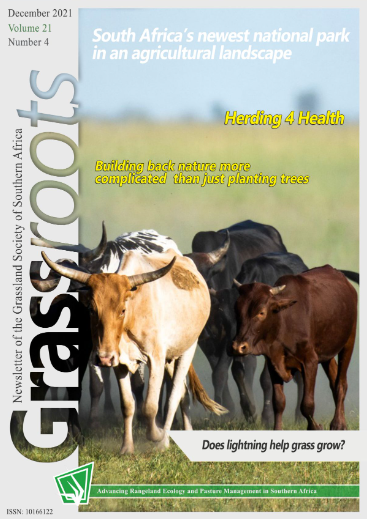
December 2021
Patrick Rakau shares valuable information on how to manage the grazing cycle of annual ryegrass in our feature article. Herding 4 Health is a community development activity that promotes conservation outcomes while supporting people living in rural areas to find their way out of extreme poverty. Read more about it on page 10. Biodiversity research in South Africa is currently being choked by red tape. How can this issue be overcome? Valuable research on post fire changes in the Overberg Renosterveld is being conducted by the Overberg Renosterveld Conservation Trust using repeat photography. Be sure to check out the submission deadlines to Grassroots for 2022 and share your exciting research findings with us. Please remember that Grassroots is also now open for advertising (see pricing options on page 19).
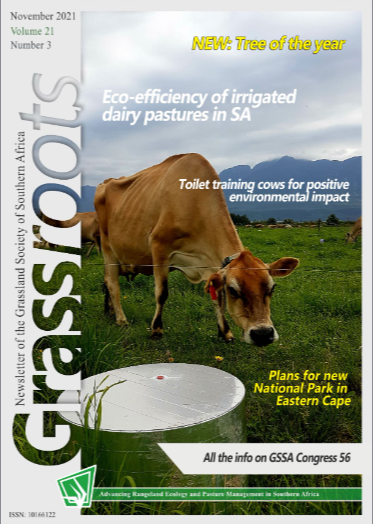
November 2021
We pay tribute to one of the founder members of the GSSA, Dr Piet Roux, who passed away on 30 June 2021. Most of his life was dedicated to understanding Karoo ecology and he was an inspiration to many young scientists and farmers. Our hearts go out to his family. Henk Smit has written an insightful article on the eco-efficiency of irrigated dairy pastures in South Africa. This study identifies opportunities to pro-duce climate-smart dairy products in South Africa and is definitely worth the read! Make sure to scan the QR-codes for the two published articles on this subject. Who would have ever thought it is possible to “potty train” a cow? Read all about exactly how and why researchers of the University of Auckland have engaged in such a “crazy” study. A new national park is on its way for the Eastern Cape and the City of Cape Town is implementing a “No Mowing” policy. We celebrate the “Tree of the year” and also learn why tree planting schemes can destroy rangelands and damage pastoral livelihoods.
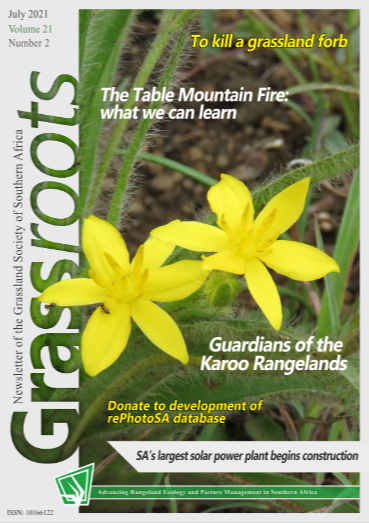
July 2021
Craig Morris wrote an insightful feature article, “To kill a grassland forb” where he addresses the role of fire and overgrazing in the mesic grasslands. As with many parts of the world, the Karoo has been undergoing desertification and in the article “Guardians of the Karoo Rangelands”, we learn how regenerative land management is bucking this trend. Two farmers from the Eastern Cape also share how they use technology and regenerative farming to successfully manage livestock. The ARC employed a soil testing lab on wheels to assist farmers in rural areas, meanwhile, in Australia and New Zealand, farmers are participating in the “Soil Your Undies” Challenge. The state of cotton underwear after being buried in the soil for 8 weeks is used to indicate the health of the microbiome. We revisit the horrific Cape Town fire that destroyed UCT’s Plant Conservation Unit to assess the damage, miracles, causes and what we learned from it. The role of invasive alien plants in this event is also discussed. Be sure to check out the new guide on “how to best get rid of invasive alien plants”. Lastly, we pay tribute to one of the world’s greatest scientists, Bob Scholes, who passed away earlier this year (make sure to watch the video tribute by ReWild). Grassroots would like to extend our sincere condolences to his family, colleagues and students.

March 2021
A new series, “Tree of the month”. Vachellia erioloba is the first tree under the spotlight. The grass and pasture of the month is Dactyloctenium australe and Avena sativa. In our feature article, Kelly Bernard focusses on birds as agents of restoration in the Albany Thicket Biome of the Eastern Cape province. The reason for the death of 350 elephants in Botswana is once again a talking point after questions were raised as to why only elephants died from cyanobacterial poisoning. It is believed that fences played a major role in causing these deaths. On the other side of the world, the possibility of fenceless grazing for cows and wildlife is being explored with the use of GPS collars developed by a Norwegian company, Nofence. Some good news is that South Africa achieved a crucial milestone for ecosystem research and that abundant rainfall in Namibia has turned this country green.
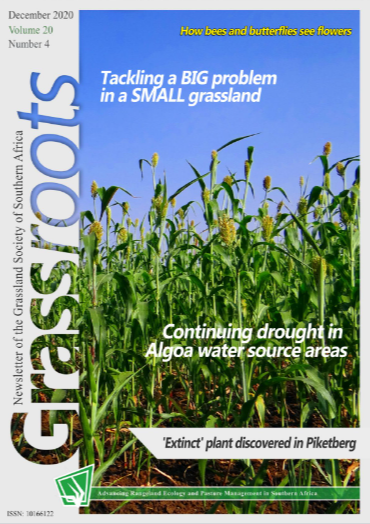
December 2020
Two of the GSSA’s Congress 55 award winners, Robyn Nicolay and Anisha Dayaram, have written feature articles on the work they have been doing and presented at the congress. The spotlight falls on wire grass (Elionurus muticus) and forage sorghum (Sorghum spp.) in our grass and pasture feature of the month. A few mysteries are solved as we finally learn the reason for the deaths of 350 elephants in Botswana and the reason for the mysterious ‘fairy circles’ in Australia and Namibia. Discoveries were made as researchers found a new grass species in the Maloti-Drakensberg area and a PhD student found an ‘extinct’ plant in Piketberg. There is also a new app for karoo plant identification that you can download and try out this holiday season.
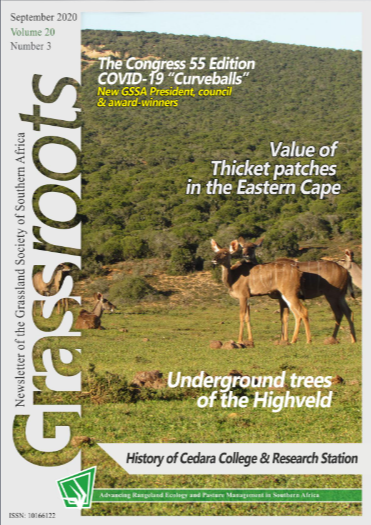
September 2020
The GSSA recently held its 55th and first virtual congress. In this issue, Debbie Jewitt and her team share some of the "curveballs" thrown their way and give a few pointers on organising a virtual event. In a preliminary study, Rina Grant asks an interesting question on whether thicket patches in the Eastern Cape have any value. Richard Gill gives us some great insights on underground trees of the Highveld. We learn more about the recent deaths of more than 350 elephants in Botswana, and a new study showed that painting eyes on the backsides of livestock can protect them from being attacked by carnivores.

June 2020
We start this issue with some “AWNSOME” research Craig Morris has been doing on Themeda triandra awns. In his article, Craig looks at how T. triandra awns work and whether long awns are better than short awns at transporting seed across the soil to a suitable germination site, and in the process, describes the intricacies of awn racing. As usual, this month’s news articles vary greatly from climate change, locust outbreaks and increasing black rhino numbers to fire regimes, impact of drought on biodiversity and cattle farming. In these unexpected and changing times, we also include an article on Covid-19 or the pandemic of mistreated biodiversity. Finally, a new book on holistic management was released late last year. Paulina Flores reviewed it for us and provides us with an in-depth summary of this latest handbook on holistic management. We are also sad to announce the deaths of two of our members and we remember them with tributes from two of their colleagues and friends.
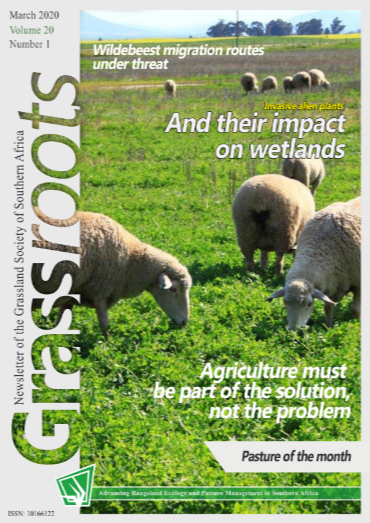
March 2020
This first issue of the year begins well with two feature articles. In the first article, Hugh Pringle, from Australia, questions whether gully erosion is a major issue for key biodiversity values. Pringle, and his colleagues have done some work on this in Namibia and feel that it is an important question which then links up with one of our news articles by Heinz Meissner on further perspective and results on high density rotational grazing. Secondly, Nelmarié Saayman presents her preliminary findings on the impact of rehabilitation of old potato circles on soil biology and seedbanks within the Western Cape Sandveld. In this issue, we present a variety of news articles on current issues relating to grassland management, both locally and internationally. These range from climate change to alien invasive alien plants, fire and new pasture crops. We also congratulate the society’s current president, Debbie Jewitt, who is part of a team of drone professionals to publish a book on contemporary drone issues – a valuable book for any drone enthusiast.

November 2019
We have two feature articles in this issue: Craig Morris investigates how key forbs can indicate the condition of mesic grasslands and the team of Happy Msiza and Khuliso Ravhuhali from the North West University ask whether bush encroachment in the Ratlou Municipality in the North West province is creating a threat to livestock production. We also have a variety of recent news articles ranging from biomass reducing erosion rates in the sandy areas to impacts of elephants on large trees and solar and wind energy.

September 2019
The 54th congress of the GSSA was recently held in Upington. This was a great success and delegates enjoyed the diversity of the Northern Cape. This year the congress started differently where tours were held at the beginning of the event and ran concurrently with the Research Skills Workshop: An introductory course to the statistical programme, R. This issue of Grassroots contains some of the highlights of the event. In this issue, Justin du Toit presents us with a neat solution to what the singular word is for cattle. Something useful for next time we need to refer to a single bovine animal!
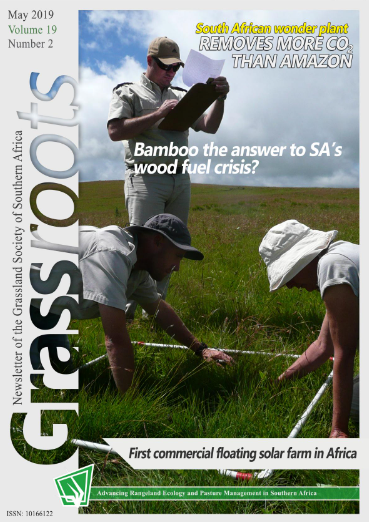
May 2019
In this full edition, we start with a feature article by Everson et al., where we are introduced to some new research on bamboo in South Africa. In our second feature article, Charné Viljoen presents recent research on nitrogen application rates on planted pastures. Finally, Costas Zachariades, from the PHP-ARC announces the introduction of the Tradescantia tip beetle into South Africa. This beetle has been bred as a biocontrol for Tradescantia fluminensis (Wandering Jew), an invasive alien plant that is affecting the recruitment of forest trees in the higher rainfall areas of SA.

March 2019
We start this year with good news and sad news. We are very proud of one of our founder members, Dr Winston Trollope, who has been awarded the 2018 Henry Wright Lifetime Achievement Award for his significant contribution to fire ecology and management in grasslands and shrublands, through the Association for Fire Ecology. The African Journal of Range and For- age Science has recently published a special issue focusing on research in the Karoo. This is a much-needed special issue as it has been over a decade since a research journal has dedicated one of its issues to the Karoo. For more information, have a look at the advert in this issue.

December 2018
Welcome to the fourth and final edition of Grassroots for 2018. As usual, this publication contains a variety of news articles and a feature article by Chloe Maclaren, one of our members who is currently completing her PhD. Chloe introduces us to a method of integrating sheep into crop rotations – this aids in managing weeds which can save money and protect the environment.

September 2018
After a successful GSSA congress held at the ARC Training Centre at Roodeplaat in July, we share some memories through photographs, a summary of the conference and the presidential address. In this edition we also have 2 feature articles; the first one looks at a way to be resourceful with some field equipment. Russell et al. have worked with developing a homemade radiation shield and discuss the complexities and uncertainties for measuring ambient temperature in the field. The second feature article presents the research of Mwendia et al. who has looked into the challenges and opportunities for forage feed systems in East Africa.

August 2018
Inside you will find several local news articles and a few relevant international news articles resembling the multi-disciplinary quality of the society, one feature article, and one opinion article. The question is asked whether conservation strategies needs to be more compassionate; ecologists look at what they can learn from native knowledge; how carnivores could help farmers; response to planted-pasture species listed as potential invasive species; climate change risk in biodiversity hotspots; organic soil fertility; well-managed renosterveld during drought; superhero fly; sustainable energy; project rhino; save the giraffe from extinction; tracking Valchellia spp. in Kalahari Gemsbok National Park; vultures and water catchment; Lower Orange River Riparian Project; and a feature on the scrap value of farm land.
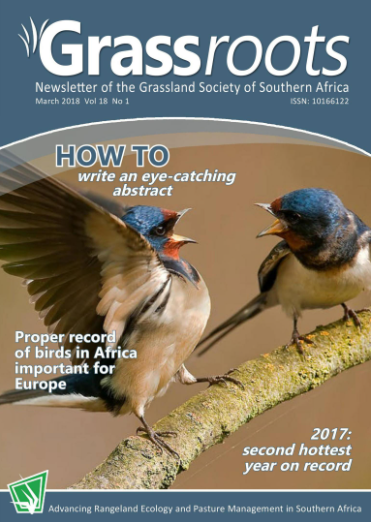
March 2018
Inside you will find two reader’s letters, several international and local news articles resembling the multi-disciplinary quality of the society, two feature articles and a tribute to one of our late members, Dr Moto Lesoli. The first feature article by Craig Galloway focuses on how dairy farming could potentially focus on being both economically sound and environmentally friendly. Dr Mehrdad Jalalian gives some valuable tips on how Writing an eye-catching and evocative abstract for a research article in his feature article.

November 2017
This issue is jam packed with multi-disciplinary news articles, GSSA52 congress feedback articles, book reviews, feature articles and snippets of the new council members. This issue contains three feature articles. Two of the feature articles focus on the Komga and Coastal Thornveld of the Eastern Cape, assessing veld condition and evaluating the impact of browsing and fire on species composition, respectively. The third feature article emphasises the influence of soil fertility on pasture growth.

August 2017
This issue takes a look at the latest developments of the International Year of Rangelands and Pastoralists Initiative. It also contains two opinion articles focused on soil health and legume based pasture systems, while the one feature article discusses the effect of bush encroachment and grazing on species in coastal thornveld of the Eastern Cape.
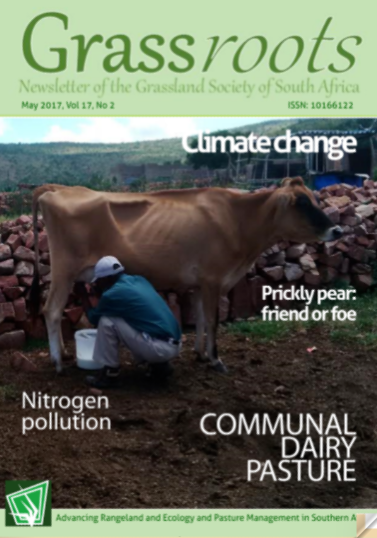
April 2017
In this issue, we pay our respects to the late Bryan Mappledoram – a scientist who contributed significantly to South African agriculture during 40+ years of research and through the various leadership roles he played. The first feature article stresses the critical state of communal dairy pastures dominated by Increaser IIc species. The need for livestock feed supplementation and pasture improvement with resilient species cannot be ignored, while the second article highlights the surprising carbon sequestration ability of creeping prickly pear.

November 2016
In this issue we take a look at the happenings of the CITES COP17 held at Joburg during Sep and Oct 2016. Also more CITES are put in plain words and the protected are being protected. Drought is still a hot topic and the quest for resilience is on the move. Another citizen science success story: the GROW observatory. The feature article focusses on the impact and management of invasive species in the communal rangelands of Zim.
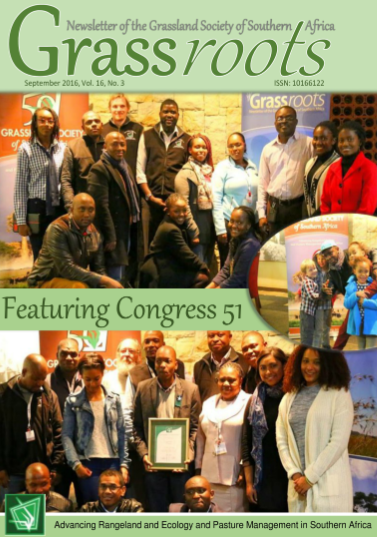
September 2016
Featuring the 51st Annual Congress of the Grassland Society of SA, Remotely Piloted Aircraft in Rangeland Management, Virtual Reality as a Tool for Conservation and much more!
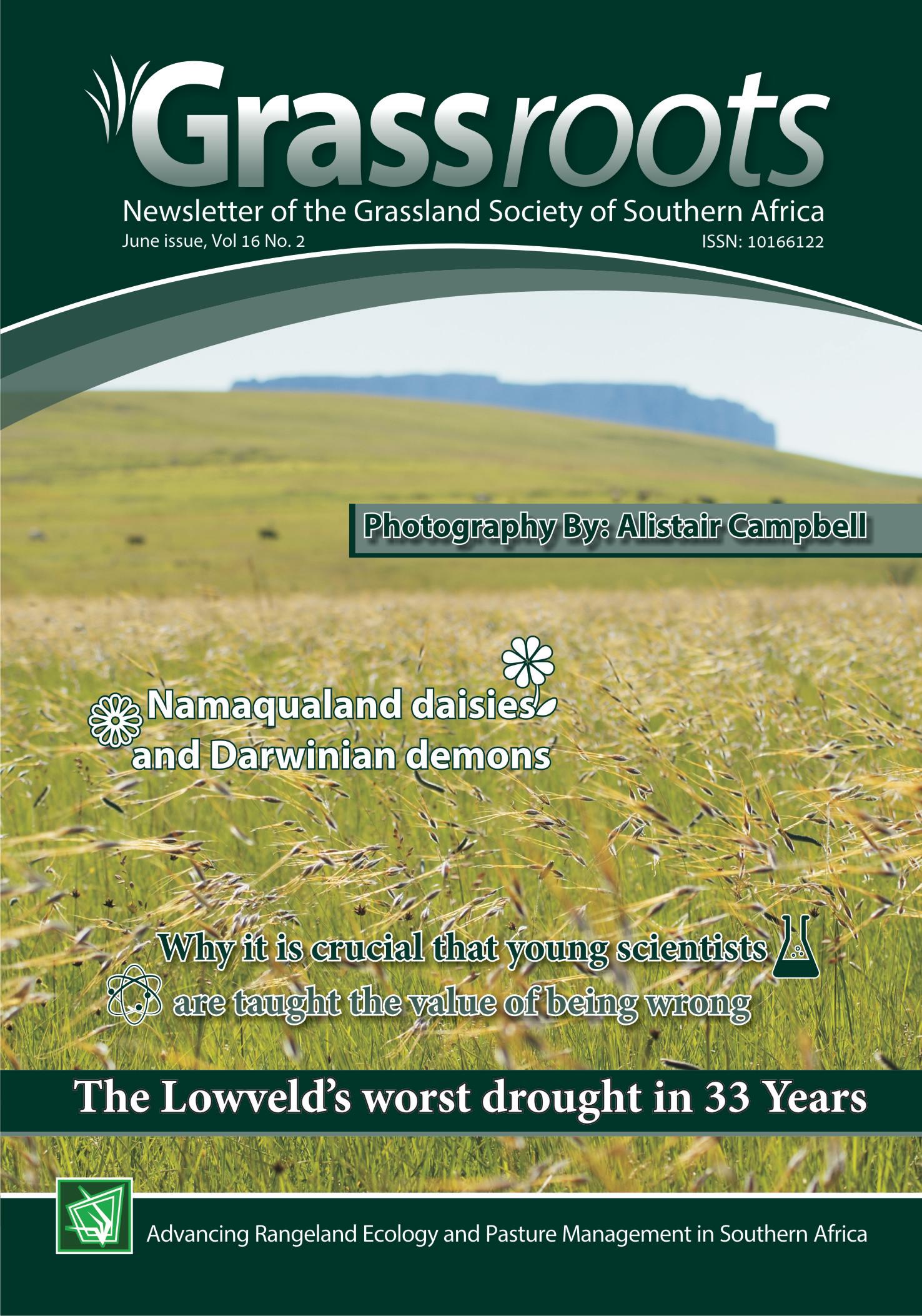
June 2016
The main feature article focuses on the gripping drought the country has faced in the past year, with a specific focus on the Lowveld region. There are also two articles that will be of particular interest to our early career grassland scientists, focusing on the art of reading a scientific paper and the importance of knowing the value of being wrong.

March 2016
This issue contains three feature articles. The first relates to applying key concepts to achieve optimal rangeland management by Richard Fynn. The second is on use of native shrubs in drought stricken crops in Sub-Saharan Africa. The third article is a commentary article on why smart agricultural development is needed in Africa’s savannas.

November 2015
Although this issue focusses on the Congress which had a historical thread throughout the programme, we also draw attention to the future by highlighting relevant research topics which require attention. You will also find two very interesting feature articles in this issue. The first is on Karoo invasion of sweet prickly pear and the second on the impact of savanna fires on Africa’s rainfall patterns.
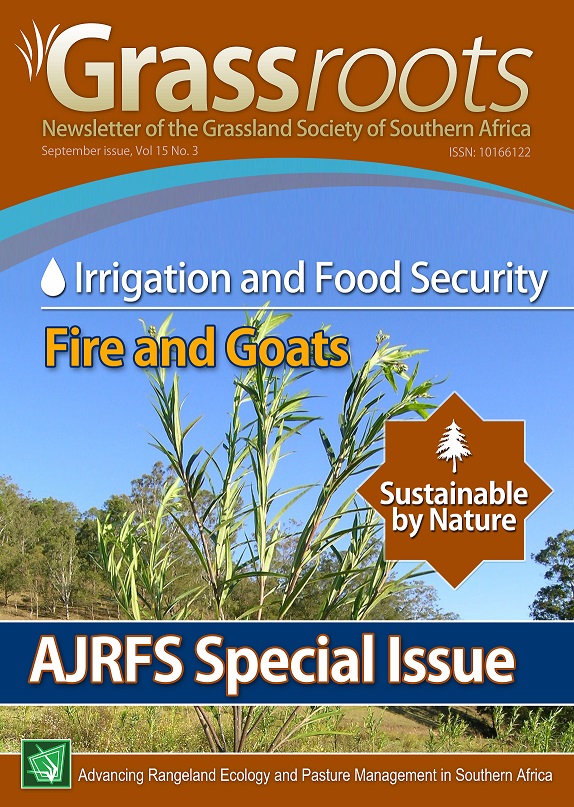
September 2015
This issue of Grassroots contains four feature articles where a variety of interests are covered. These range from sustainable agriculture to the impact of fire and goats in the Thornveld region of the Limpopo region. Dr. Felix Reinders presents his ideas on global food security in his article on irrigation and food security.

May 2015
For this issue we bring you three feature articles. Parthenium hysterophorus is a problem plant which is invading grazing, cultivated, fallow and protected areas for the conservation of biodiversity. In a feature article by Lorraine Strathie, challenges with this weed are identified, and successful biocontrol management of this plant is discussed. In the second feature article, the impact of soil moisture balance on bush encroachment is debated. Finally, Research results from Outeniqua Research Farm near George, provides the latest information on establishing grass-legume mixtures into kikuyu using various mechanical and herbicidal methods.
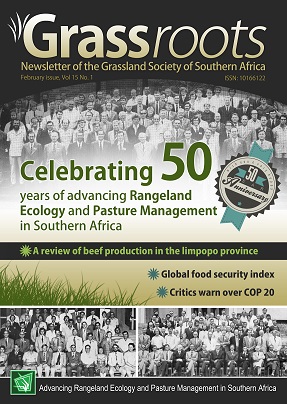
March 2015
In July this year, the GSSA Congress will celebrate its 50th anniversary. The first Congress was held in 1966 at the then University of Natal, Pietermaritzburg. The Society will be returning to its roots in 2015, with the 50th Annual Congress hosted by the KwaZulu-Natal Province at the Royal Agricultural Showgrounds in Pietermaritzburg. A number of snippets of relevant news are published along with a feature article by Dannhauser et al. on the importance Cenchrus ciliaris for beef production systems. A helpful article on how to write a proper conclusion is published in this issue which is specifically aimed at young scientists.
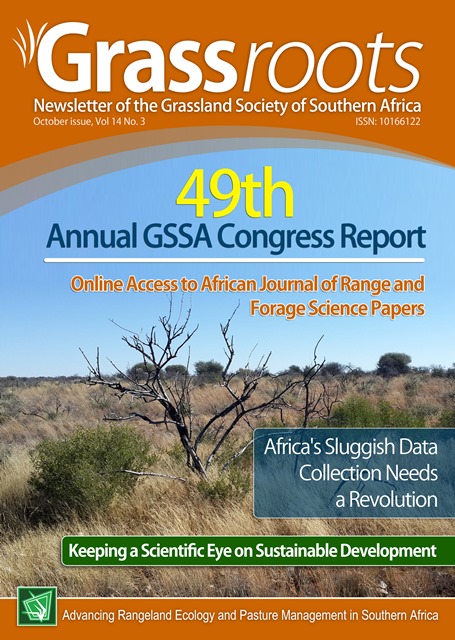
November 2014
After many years, the debate about Allan Savory’s theory on holistic management of veld, its remarkable stocking rates and the system’s ability to reduce desertification and reverse climate change continues. Is there enough scientific evidence to support his theories? Read more about this controversial issue herein and feel free to send is your comments.

August 2014
Writing remains the key medium of communication and the link between initial conceptions, plans, execution, outcomes, experiential learning, and the next project. The first feature article in this edition focuses on concepts which are important to consider when writing scientific and technical articles. The second feature article of this issue provides facts and figures of sustainable food production. The importance of research and development outcomes on this is conveyed in advances in agricultural science and technology having contributed to remarkable increases in food production since the mid-twentieth century.
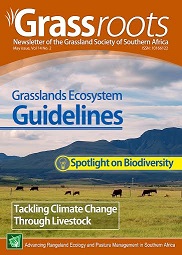
May 2014
The feature article for this issue, contributed by Dr. Albrecht Glatzle provides his contrasting positions on the recommendation by the FAO to reduce the number of ruminants at a global scale in order to mitigate climate change.

March 2014
This issue contains two feature articles relating to temperate pastures, one from the dairy producing southern Cape region, and the other on beef production in the North-West province. These articles provide information on supplementation of ryegrass to deliver high quality feed intake all-year round, and the clover or trefoil cultivars best adapted to the local environment and climate and how they fit into specific pasture systems.
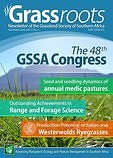
November 2013
This issue includes two feature articles. The first article gives practical information on the influence of planting dates on the production potential of Italian and Westerwolds ryegrass. Likewise, the second article provides valuable information about the management of medics in wheat-medic systems in the Swartland region of the Western Cape.

August 2013
In this issue you will find two very interesting feature articles , one on annual legume seedling and seed populations in commercial crop-pasture systems in the agropastoral region of the Western Cape and the second on increasing effectiveness of rangelands and the lessons we can learn from wild herbivores.
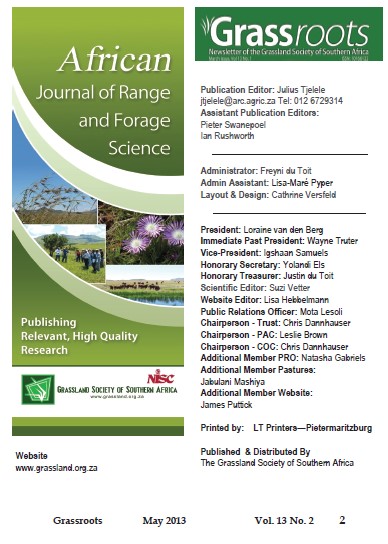
May 2013
Improving our understanding of Carbon Management; African Seed Trade Association Congress: Meet the Members.
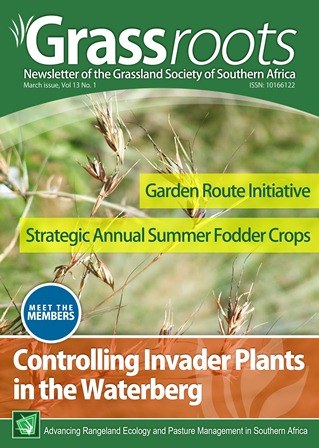
March 2013
With contributions from three of our members, the feature articles focus on a broad range of topics including: how the Modimolle Junior Land Care project is helping to control invader plants, how forage sorghum and hybrid millets can be strategically implemented as summer fodder crops and how washing of roots does not remove sand implications in pot experiments.
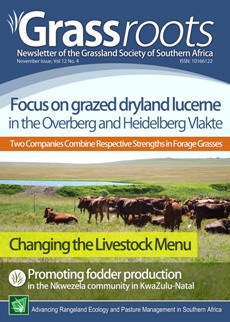
November 2012
This issue contains two feature articles related to lucerne production in the Swartland, Overberg and Heidelberg Vlakte.Valuable information about lucerne’s exceptional forage properties,which makes it the most productive pasture legume in the Western Cape, is revealed. Motivating approaches on the promotion of fodder production in KZN’s rural areas are inspirational and is included as another feature article. Keep reading to find more interesting articles in this issue.
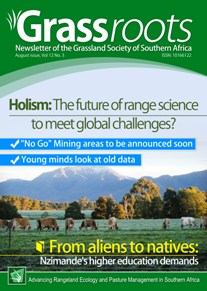
August 2012
In this issue: Holism: The future of range science to meet global challenges, No go mining areas to be announced, Young minds look at old data, From aliens to natives: Nzimande`s higher education demands.

May 2012
This issue of Grassroots features an article on ‘Presentation skills” – this came at the right time with the Annual GSSA Congress coming. We are also focusing specifically on Dryland Lucerne in the Overberg region with three bumper features on the subject.
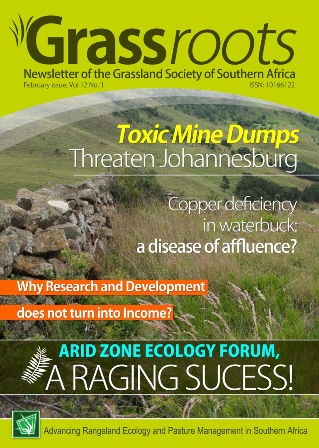
February 2012
In this issue: Toxic mine dumps threaten Johannesburg, Copper deficiency in waterbuck: a disease of affluence?, Why research and development does not turn into income? And Arid Zone Ecology Forum: A raging success.

November 2011
The effects of climate change on South Africa, An extraordinary life - focus on Wangari Maathai, Eskom Expo 2011, Resisting the alien invasion in Kruger, Hungarian Tour - report and Rangeland rehydration - EMU style.
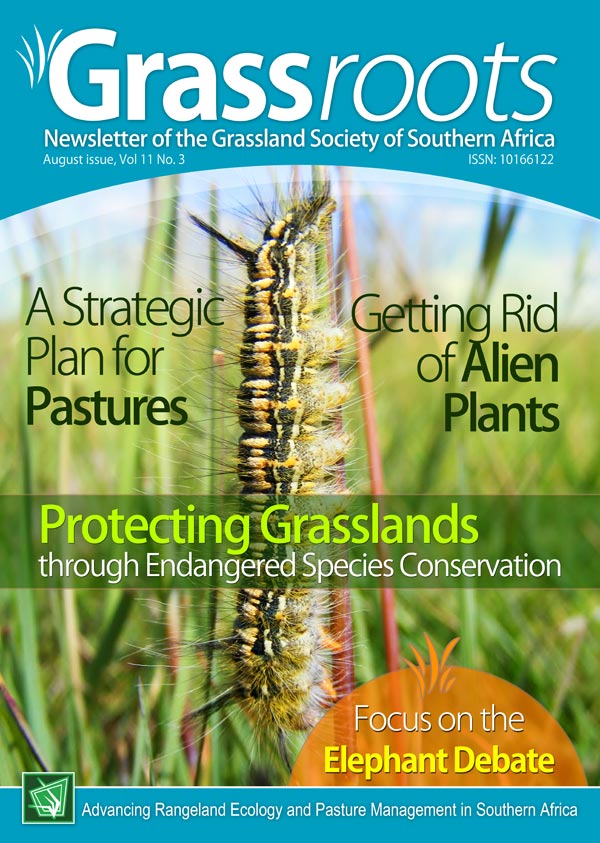
August 2011
In this issue a strategic plan for revitalizing the field of cultivated pastures is laid out by Professors Wayne Truter and Chris Dannhauser, Other articles focus on getting rid of alien plants, protecting grasslands through endangered species conservation and the elephant debate.
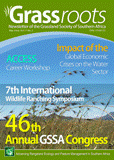
May 2011
Access career workshop, Impact of the global economic crises on the water sector, 7th International wildlife ranching symposium, 46th Annual GSSA Congress.
February 2011
In this issue: Climate change impacts on plants, Root studies, Conservation status of temperate grasslands, Eco-hydrological changes.
November 2010
A bumper edition of the Grassroots with seven feature articles covering a range of subjects including biodiversity, rehabilitation and restoration strategies and how to approach running long term trials.
August 2010
This issue is packed full of original feature articles on a wide range of subjects. These include articles discussing whether soil disturbance is necessary for patch restoration in the Nama Karoo, fire mediated succession and reversion of woody vegetation in Natal, a report on a clearing trial on invasive species in the Eastern Cape and ho land management is impacting the water cycle in Zimbabwe.
May 2010
In this issue you can find information on the longevity of grass seeds in semi arid grasslands, how planting date will affect the yield of forage sorghum hybrids and hybrid millet and the effect of Acacia Mearnsii removal on water table fluctuations in the Eastern Cape.
February 2010
In this issue a broad range of subjects are covered by our feature articles including a focus on biodiversity, invasive species control, extensive vs. intensive beef finishing and two articles on methodology in rangeland research.
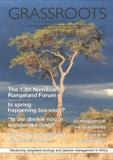
November 2009
This issue contains two reports on recently held forums, namely the 13th Namibian Rangeland and the 3rd Annual Grassland Partners' forum. Other interesting subjects covered include a framework for rangeland monitoring and management within arid and semi-arid rangelands, leafhoppers in South African grasslands and donkeys in Namaqualand.
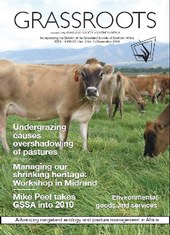
September 2009
Two feature articles in this issue focus on clovers in pastures, while the other features cover grassland conservation in Midrand and medium term changes in the grazing capacity of the Rolfontein Nature Reserve.
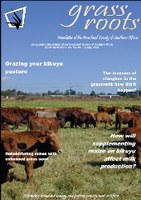
May 2009
In this issue you can find articles on how seed treatment impacts rehabilitation practices, two articles on management of cows on kikuyu pastures and the management of problem plants like Seriphium plumosum and black wattle.
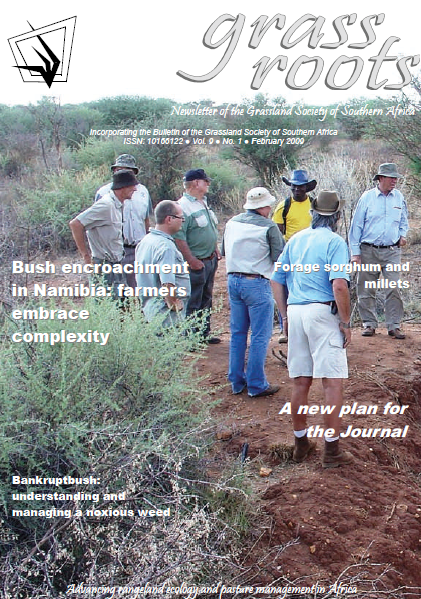
February 2009
This issue includes two articles on Seriphium plumosum (Slangbos). Other subjects covered include bush encroachment in Namibia, plant species richness assessments of the Makuya Nature Reserve and planting strategies for forage sorghums and millets.
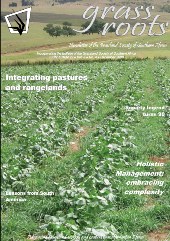
December 2008
A great edition of the Grassroots, with the first contribution from Allan Savory on embracing the complexity of rangeland management through holistic management. A interesting article on how to link cultivated pastures to rangelands is the next feature. Other topics covered include grass impressions of South America and the International Carbon Sequestration meeting.
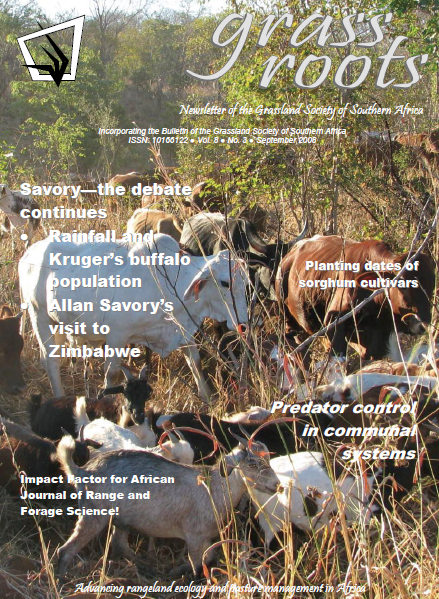
September 2008
A great issue to have one rethink our opinions with articles on issues such as predator-human conflict in livestock systems, challenges and contestations in communal grazing and holistic management again n the spotlight.
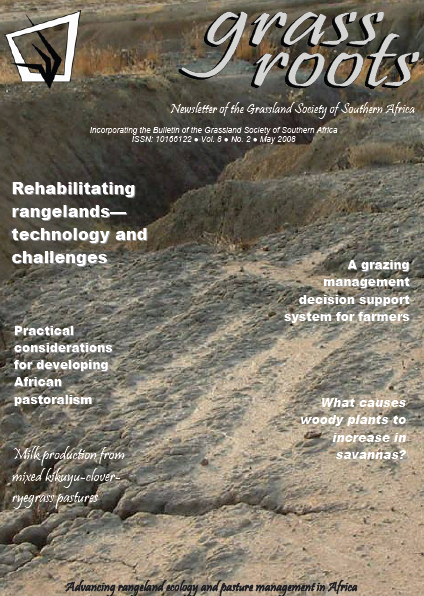
May 2008
This issue has a strong focus on the GSSA as a society and its role. Other feature articles relate to a broad range of subjects including woody plants in savanna ecosystems, grazing management using a computer model, kikuyu based pasture systems for dairy and African pastoralism.
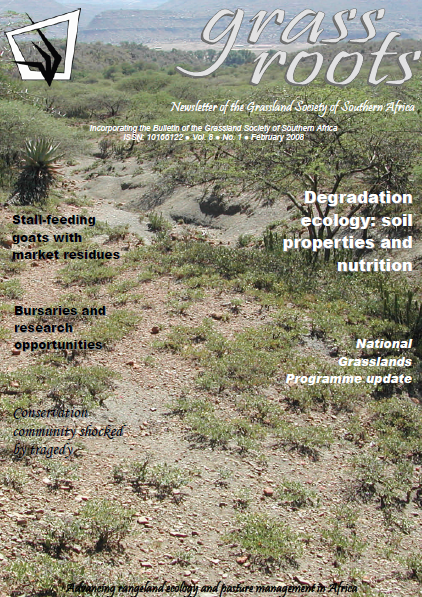
February 2008
A jam packed issue of the grassroots- with various reports on recent grassland related events and articles focusing on rangeland and pasture management.
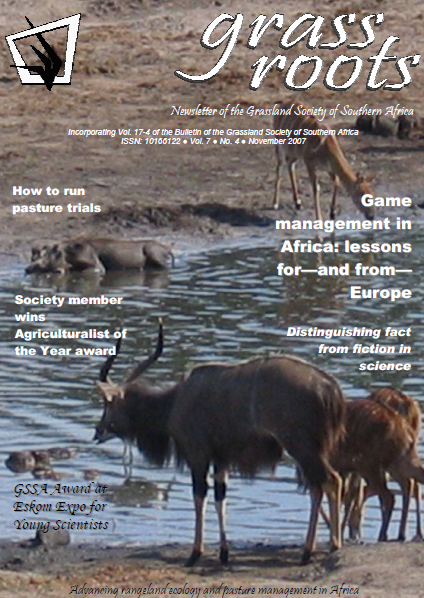
November 2007
In this issue there are some great articles on how to run pasture evaluation trials, science versus pseudoscience and cactus pear water utilisation.
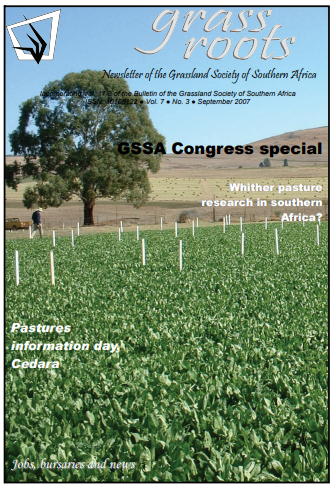
September 2007
Various articles reporting on the GSSA annual congress and a Pastures Information Day held for small scale farmers at Cedara in KZN.
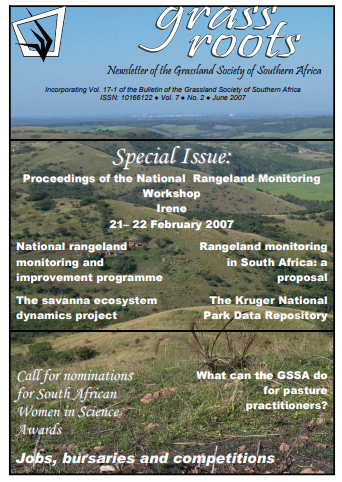
June 2007
A great issue for grasslands scientists, with articles on what the GSSA can do for pasture practitioners, the national rangeland monitoring an improvement program, the Kruger National Park data repository and a report on the Rangeland Monitoring Workshop.
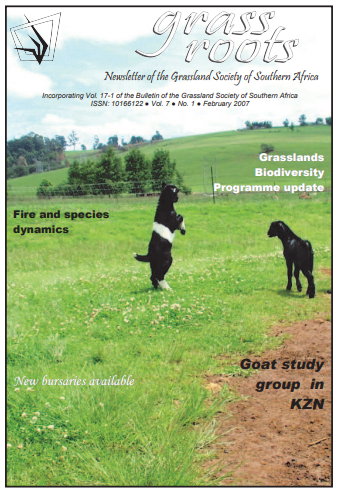
February 2007
In this issue: goat study group in KZN, fire effects on unpalatable species and grasslands program update.

December 2006
In this issue reports are given on "The future of Dairy Farmers in South Africa Conference" held at Cedara and the Agricol Farmers day held at Mooi River. A feature article by Prof Snyman discusses the short term influence of fire in semi-arid grassland as it relates to defoliation, while Donavan Kotze focuses on Glyceria maxima as a highly invasive grass of Drakensberg wetlands.
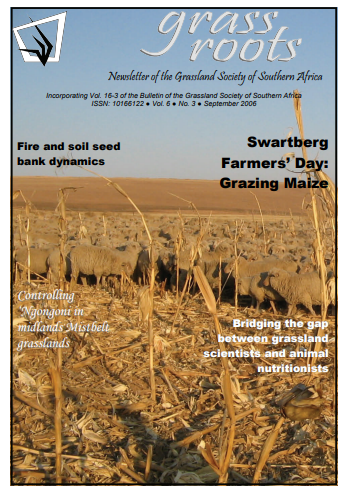
September 2006
The feature articles in this issue focus on a broad range of subjects. An article by DE Short discusses the importance of correctly supplementing grazing livestock on veld. The series by Prof Snyman on the short-term influence of fire on semi-arid grassland continues, this time focusing on the soil seed bank. Finally, Cobus Botha provides information on how height selective herbicide treatment can be used to facilitate veld restoration.
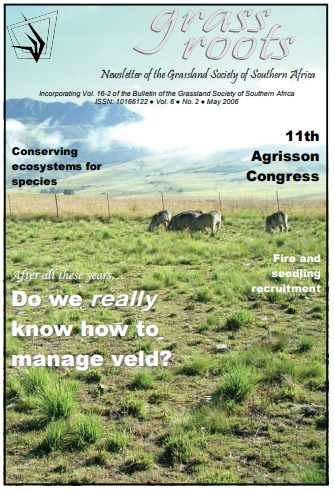
April 2006
This issue contains three feature articles. The first article discusses using a combined approach when undertaking ecosystem conservation. The second, contributed by Craig Morris, focuses on the current state of knowledge on veld and natural resource management. While the last feature discusses the short term effect of fire in semi-arid grassland on seedling establishment.
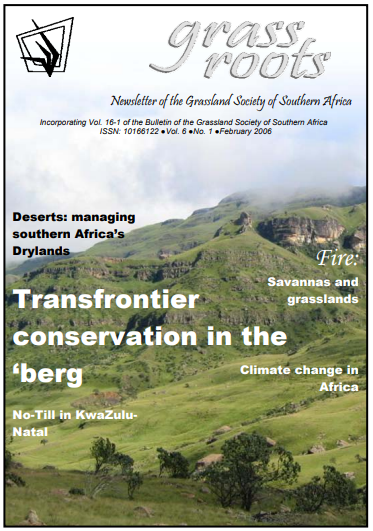
February 2006
A bumper issue of Grassroots with no less than seven feature articles. Subjects covered include the impact of climate change on savannahs, the Desert Margins Program in South Africa, fire impacts on grassland soil characteristics, impacts of large area burns in the Kruger National Park, conservation in the Maloti-Drakensberg region and no-till in the Dairy industry.
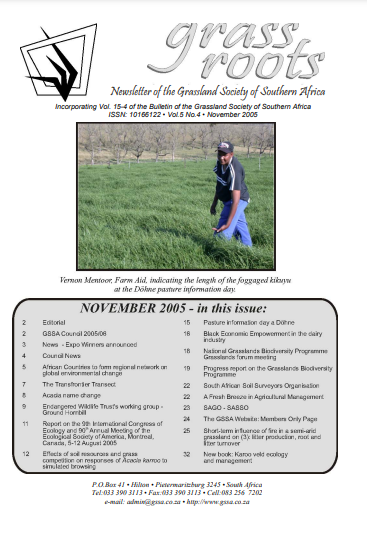
November 2005
A great issue, with numerous feature articles, reports on various working groups and programmes and some GSSA news.

August 2005
A great issue of Grassroots, packed with feature articles covering subjects that include effects of fire on grasslands, soil-seedbank interactions, plant secondary compounds and the KZN Biodiversity program. Also included are articles covering the Pasture Endophyte Workshop and a session on Livestock Development in Communal Rangelands presented at congress 40.
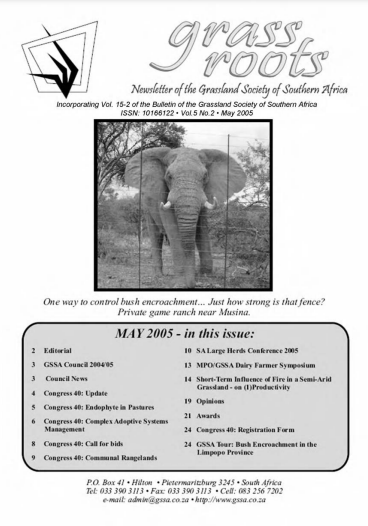
May 2005
A issue with a strong focus on the GSSA- congress workshops, GSSA 40 and GSSA congress tours.

February 2005
An interesting article in this issue outlines a new strategic action plan for the GSSA, with a total of 14 objectives listed. Also included are three feature articles related to the effect of grazing on grassland biodiversity, cowpeas as a fodder crop and simplified techniques for assessing the condition of a grass sward.
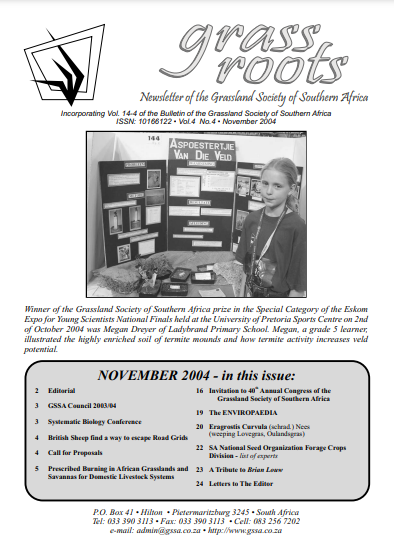
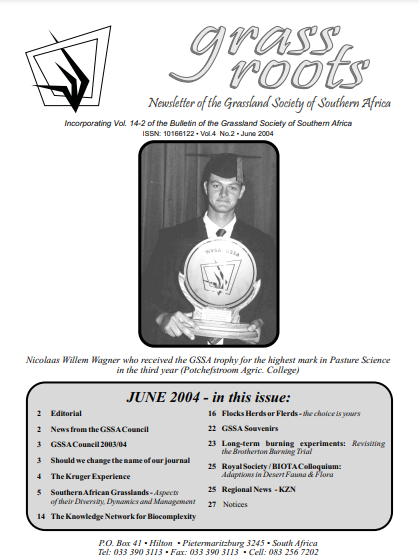
June 2004
A must read, containing a feature article by Alan Short on the Long term burning trial at Brotherton. Also included are a book review, an article on "Flocks Herds and Flerds" and transcription of a presentation by Prof Braam van Wyk on the biodiversity, dynamics and management of South African Grasslands delivered at the "Timber Plantations: Impacts, Future Visions and Global Trends" Conference held at Nelspruit.
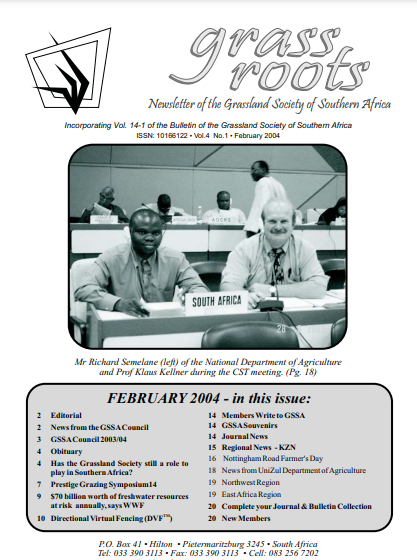
February 2004
Featuring regional news from KZN, North West and even Eastern Africa, this issue provides both insights into the technical world of grasslands and general goings on.
